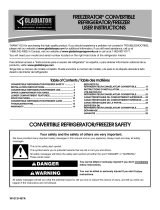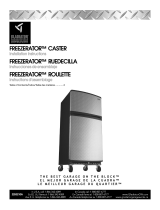
8
REFRIGERATOR USE
Using the Controls
For your convenience, your refrigerator controls are preset at the
factory. When you first install your refrigerator, make sure that the
controls are still preset to the mid-settings as shown.
NOTE: To turn your refrigerator off, turn the refrigerator control to the
word OFF or until the word OFF appears. Your product will not cool
when the refrigerator control is set to OFF.
Mid-setting “3”
Mid-setting “3”
IMPORTANT:
■ Give your refrigerator time to cool down completely before
adding food. It is best to wait 24 hours before you put food into
the refrigerator.
■ If you add food before the refrigerator has cooled completely,
your food may spoil. Adjusting the Refrigerator and Freezer
Controls to a higher (colder) than recommended setting will not
cool the compartments any faster.
Adjusting Controls
The mid-settings indicated in the previous section should be correct
for normal household usage. The controls are set correctly when milk
or juice is as cold as you like and when ice cream is firm.
If the temperature is too warm or too cold in the refrigerator or
freezer, first check the air vents to be sure they are not blocked.
If you need to adjust temperatures, use the settings listed in the chart
below as a guide. On models with two controls, adjust the
refrigerator temperature first. Wait at least 24 hours between
adjustments and then recheck the temperatures.
REFRIGERATOR CARE
Cleaning
Both the refrigerator and freezer sections defrost automatically.
However, clean both sections about once a month to avoid buildup
of odors. Wipe up spills immediately.
IMPORTANT: Because air circulates between both sections, any
odors formed in one section will transfer to the other. You must
thoroughly clean both sections to eliminate odors. To avoid odor
transfer and drying out of food, wrap or cover foods tightly.
To Clean Your Refrigerator:
NOTE: Do not use abrasive or harsh cleaners such as window
sprays, scouring cleansers, flammable fluids, cleaning waxes,
concentrated detergents, bleaches or cleansers containing
petroleum products on plastic parts, interior and door liners or
gaskets. Do not use paper towels, scouring pads, or other harsh
cleaning tools.
1. Unplug refrigerator or disconnect power.
2. Hand wash, rinse, and dry removable parts and interior surfaces
thoroughly. Use a clean sponge or soft cloth and a mild detergent
in warm water.
3. Wash stainless steel and painted metal exteriors with a clean
sponge or soft cloth and a mild detergent in warm water.
4. There is no need for routine condenser cleaning in normal home
operating environments. If the environment is particularly greasy
or dusty, or there is significant pet traffic in the home, the
condenser should be cleaned every 2 to 3 months to ensure
maximum efficiency.
If you need to clean the condenser:
■ Remove the base grille.
■ Use a vacuum cleaner with a soft brush to clean the grille,
the open areas behind the grille and the front surface area of
the condenser.
■ Replace the base grille when finished.
5. Plug in refrigerator or reconnect power.
Changing the Light Bulbs
NOTE: Not all bulbs will fit your refrigerator. Be sure to replace the
bulb with an appliance bulb of the same size, shape, and wattage.
1. Unplug refrigerator or disconnect power.
2. Remove the bulb from behind the control panel in the refrigerator
or from behind the light shield in the freezer (on some models).
Replace it with an appliance bulb of the same wattage.
3. Plug in refrigerator or reconnect power.
CONDITION/REASON: ADJUSTMENT:
REFRIGERATOR too warm REFRIGERATOR or
TEMPERATURE Control one
setting higher
FREEZER too warm FREEZER or TEMPERATURE
Control one setting higher
REFRIGERATOR too cold REFRIGERATOR or
TEMPERATURE Control one
setting lower
FREEZER too cold FREEZER or TEMPERATURE
Control one setting lower
WARNING
Explosion Hazard
Use nonflammable cleaner.
Failure to do so can result in death, explosion, or fire.
1
2
4
5
WARMER
C
O
O
L
E
R
R
E
C
O
M
M
E
N
D
E
D
S
E
T
T
IN
G
R
E
F
R
IG
E
R
A
T
O
R
3
1
2
4
5
WARMER
C
O
O
L
E
R
R
E
C
O
M
M
E
N
D
E
D
S
E
T
T
I
N
G
FREEZER
3
A
L
L
O
W
2
4
H
O
U
R
S
B
E
T
W
E
E
N
A
D
J
U
S
T
M
E
N
T
S
ALLOW 24 HOURS BETWEEN ADJUSTMENTS
3
3












